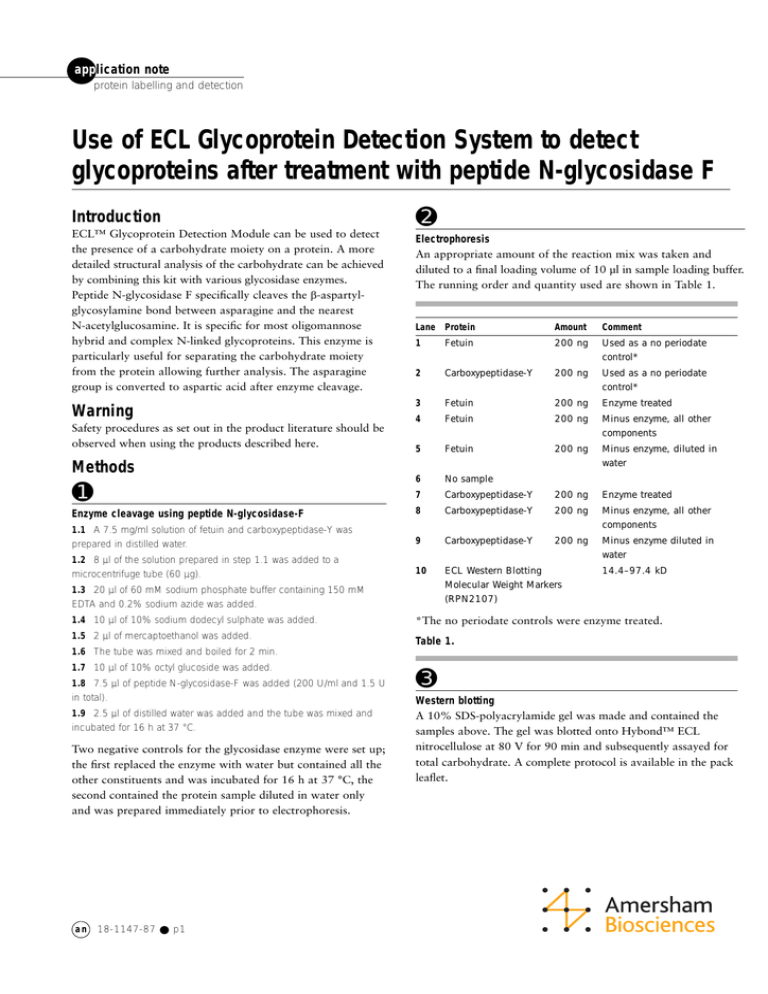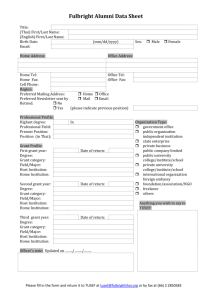
application note
protein labelling and detection
Use of ECL Glycoprotein Detection System to detect
glycoproteins after treatment with peptide N-glycosidase F
Introduction
ECL™ Glycoprotein Detection Module can be used to detect
the presence of a carbohydrate moiety on a protein. A more
detailed structural analysis of the carbohydrate can be achieved
by combining this kit with various glycosidase enzymes.
Peptide N-glycosidase F specifically cleaves the β-aspartylglycosylamine bond between asparagine and the nearest
N-acetylglucosamine. It is specific for most oligomannose
hybrid and complex N-linked glycoproteins. This enzyme is
particularly useful for separating the carbohydrate moiety
from the protein allowing further analysis. The asparagine
group is converted to aspartic acid after enzyme cleavage.
➋
Electrophoresis
An appropriate amount of the reaction mix was taken and
diluted to a final loading volume of 10 µl in sample loading buffer.
The running order and quantity used are shown in Table 1.
Lane Protein
Amount
Comment
1
Fetuin
200 ng
Used as a no periodate
control*
2
Carboxypeptidase-Y
200 ng
Used as a no periodate
control*
3
Fetuin
200 ng
Enzyme treated
4
Fetuin
200 ng
Minus enzyme, all other
components
5
Fetuin
200 ng
Minus enzyme, diluted in
water
6
No sample
7
Carboxypeptidase-Y
200 ng
Enzyme treated
Enzyme cleavage using peptide N-glycosidase-F
8
Carboxypeptidase-Y
200 ng
1.1 A 7.5 mg/ml solution of fetuin and carboxypeptidase-Y was
prepared in distilled water.
Minus enzyme, all other
components
9
Carboxypeptidase-Y
200 ng
1.2 8 µl of the solution prepared in step 1.1 was added to a
microcentrifuge tube (60 µg).
Minus enzyme diluted in
water
10
ECL Western Blotting
Molecular Weight Markers
(RPN2107)
Warning
Safety procedures as set out in the product literature should be
observed when using the products described here.
Methods
➊
1.3 20 µl of 60 mM sodium phosphate buffer containing 150 mM
EDTA and 0.2% sodium azide was added.
1.4 10 µl of 10% sodium dodecyl sulphate was added.
1.5 2 µl of mercaptoethanol was added.
14.4–97.4 kD
*The no periodate controls were enzyme treated.
Table 1.
1.6 The tube was mixed and boiled for 2 min.
1.7 10 µl of 10% octyl glucoside was added.
1.8 7.5 µl of peptide N-glycosidase-F was added (200 U/ml and 1.5 U
in total).
1.9 2.5 µl of distilled water was added and the tube was mixed and
incubated for 16 h at 37 °C.
Two negative controls for the glycosidase enzyme were set up;
the first replaced the enzyme with water but contained all the
other constituents and was incubated for 16 h at 37 °C, the
second contained the protein sample diluted in water only
and was prepared immediately prior to electrophoresis.
an
18-1147-87 ● p1
➌
Western blotting
A 10% SDS-polyacrylamide gel was made and contained the
samples above. The gel was blotted onto Hybond™ ECL
nitrocellulose at 80 V for 90 min and subsequently assayed for
total carbohydrate. A complete protocol is available in the pack
leaflet.
protein labelling and detection
➍
Total carbohydrate detection
All incubations were performed with gentle agitation at room
temperature.
The first two lanes, which were used as no periodate controls,
were carefully separated from the rest of the membrane and
assayed in a separate container. The protocol below was
followed except that the periodate in step 3 was replaced by
water.
4.1 The SDS-PAGE/Western blot was prepared as already indicated.
4.2 The membrane was incubated in PBS, for 10 min.
4.3 The membrane was then incubated for 20 min in a solution of
10 mM sodium metaperiodate dissolved in 100 mM acetate buffer,
pH 5.5. This reaction was performed in the dark.
4.4 The membrane was briefly rinsed twice in PBS then washed three
times for 10 min with fresh changes of PBS.
4.5 40 µl of 0.125 mM biotin hydrazide was added to 20 ml of
100 mM acetate buffer pH 5.5 and the membrane was incubated for
60 min in this solution.
4.6 The membrane was washed as in step 4.4.
4.7 20 ml of 5% membrane blocking agent in PBS was prepared and
the membrane incubated in this solution for 60 min.
4.8 The membrane was washed as in step 4.4.
4.9 20 ml of a 1:1000 dilution of the streptavidin-horseradish
peroxidase conjugate in PBS was prepared and the membrane
incubated in this solution for 30 min.
Results
Fig 1. Total carbohydrate labelling
The membrane contains the following samples:
lanes 1,3,4,5 = fetuin,
lanes 2,7,8,9 = carboxypeptidase-Y,
lane 6 no sample,
lane 10 = ECL Western Blotting Molecular Weight Markers
(97.4, 68, 46)
Discussion
The total carbohydrate negative control which omits the
periodate step was negative for both proteins. This indicates
that cleavage of N-linked carbohydrates has occurred and in
addition, because it is still positive for carbohydrate, O-linked
carbohydrates are also present.
No band is visible in lane 7, which contains carboxypeptidase-Y
treated with enzyme. This is because N-linked carbohydrates
in the untreated protein have been removed by the enzyme.
No O-linked groups are present.
4.10 The membrane was washed as in step 4.4.
Products used
4.11 The protocol for ECL Western Blotting Detection Reagents was
followed.
Amersham Biosciences products used for this process:
ECL Glycoprotein Detection Module
RPN2190
Hybond ECL (20 × 20 cm)
RPN2020D
ECL Western Blotting Molecular Weight Markers RPN2107
Other materials required
Tween™ 20
Product information
for further details:
Asia Pacific Tel: +852 2811 8693 Fax: +852 2811 5251 Australasia Tel: +61 2 9894 5152 Fax: +61 2 9899 7511 Austria Tel: 01 576 0616 23 Fax: 01 576 0616 27 Belgium Tel: 0800 73 888 Fax: 03 272 1637
Canada Tel: 1 800 463 5800 Fax: 1 800 567 1008 Central, East, and South East Europe Tel: +43 1 982 3826 Fax: +43 1 985 8327 Denmark Tel: 45 16 2400 Fax: 45 16 2424 Finland Tel: 09 512 3940 Fax: 09 512 1710
France Tel: 01 6935 6700 Fax: 01 6941 9677 Germany Tel: 0761 4903 406 Fax: 0761 4903 405 Italy Tel: 02 27322 1 Fax: 02 27302 212 Japan Tel: 81 3 5331 9337 Fax: 81 3 5331 9370 Latin America Tel: +55 11 3667 5700
Fax: +55 11 3667 87 99 Middle East and Africa Tel: +30 (1) 96 00 687 Fax: +30 (1) 96 00 693 Netherlands Tel: 0165 580 410 Fax: 0165 580 401 Norway Tel: 2318 5800 Fax: 2318 6800
Portugal Tel: 01 417 70 35 Fax: 01 417 31 84 Russian Federation Tel: +7 (095) 232 0250, 956 1137 Fax: +7 (095) 230 6377 South East Asia Tel: 60 3 724 2080 Fax: 60 3 724 2090 Spain Tel: 93 594 49 50
Fax: 93 594 49 55 Sweden Tel: 018 612 0000 Fax: 018 612 1200 Switzerland Tel: 01 802 81 50 Fax: 01 802 81 51 UK Tel: 0800 616928 Fax: 0800 616927 USA Tel: +1 800 526 3593 Fax: +1 877 295 8102
or visit our web-site:
www.amershambiosciences.com
Amersham is a trademark of Nycomed Amersham plc. ECL and Hybond are trademarks of Amersham Biosciences or its subsidiaries. Tween is a
trademark of ICI Americas Inc. Amersham Biosciences UK Limited, Amersham Place, Little Chalfont, Buckinghamshire HP7 9NA, England. Amersham Biosciences AB, Björkgatan 30, SE-751 84 Uppsala, Sweden. Amersham
Biosciences Inc., 800 Centennial Avenue, PO Box 1327, Piscataway, NJ 08855, USA. Amersham Biosciences Europe GmbH, Munzinger Strasse 9, D-79111, Freiburg, Germany. All goods and services are sold subject to the
terms and conditions of sale of the company within the Amersham Biosciences group which supplies them. A copy of these terms and conditions is available on request. © Amersham Biosciences UK Limited 2000 - All rights
reserved.
an
18-1147-87 ● p2

